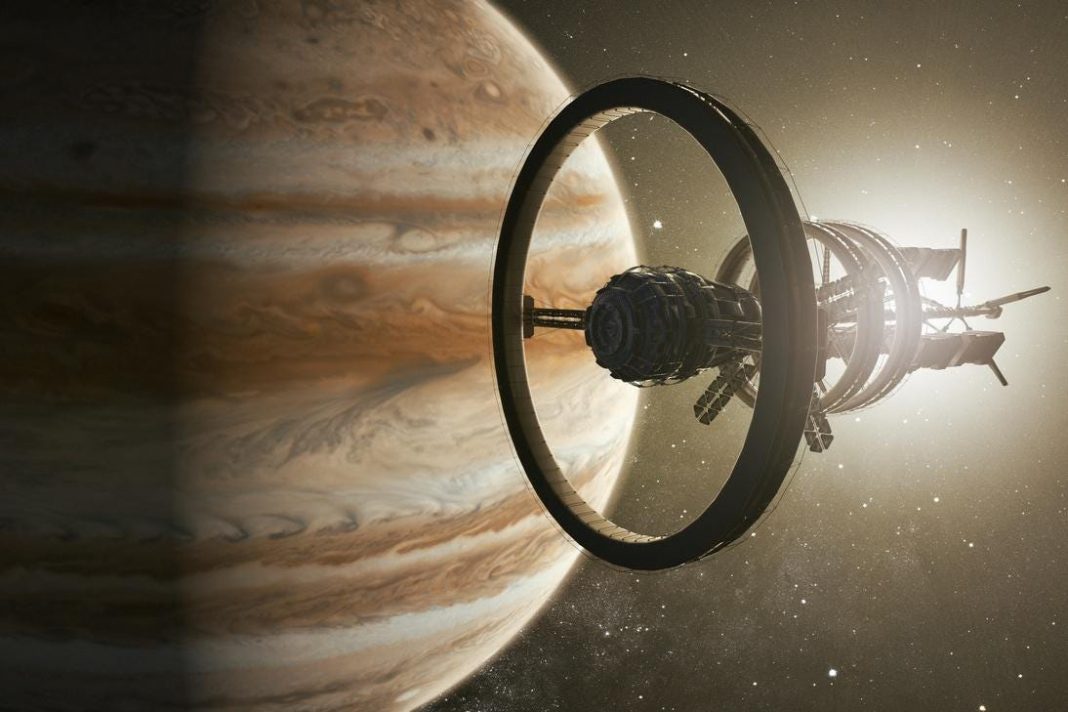Science Babies Born This Decade Could See Humans Visit Jupiter’s Moons And The Asteroid Belt Say Scientists Jamie Carter Senior Contributor Opinions expressed by Forbes Contributors are their own. I inspire people to go stargazing, watch the Moon, enjoy the night sky May 26, 2022, 08:00pm EDT | Share to Facebook Share to Twitter Share to Linkedin 3D rendering of a spaceship aproaching Jupiter getty No fewer than nine robotic missions have visited the Jovian system—home to the solar system’s largest planet, Jupiter—and in less than 80 years humans could make the 499 million miles/803 million kilometers journey. It could be preceded by crewed missions to the Asteroid Belt, which is between the orbits of Mars and Jupiter as early as 50 years from now.
However, trips to Saturn’s moons may have to wait a little longer. That’s according to a new paper published on the pre-print service arXiv, which projects the earliest possible launch dates for human-crewed missions to selected destinations in the Solar System and beyond. “Although the Solar System is dauntingly large, human intelligence brought us from the first crude heavier-than-air flight in 1903 to the surface of the Moon only 66 years later,” reads the paper.
That’s less than a current average human lifespan in developed nations. “Our model . .
. suggests human landings on worlds beyond the Moon and Mars may well be witnessed by many alive today. ” The estimates are based on extrapolations of NASA’s historic budget trend and the development trends within deep space exploration research.
They assume ever-increasing computational power. The paper produced these three key predictions: MORE FOR YOU New Research Finds A Connection Between Domestic Violence And These Two Personality Disorders This Scientist Helps Andean Forests And Ecuador’s Women In STEM Exceptional Fossil Preservation Suggests That Discovering Dinosaur DNA May Not Be Impossible A mission to the Asteroid Belt between 2071 and 2087. A mission to Jupiter’s moons between 2101 and 2121.
A mission to Saturn’s moons by 2132 (though possibly as early as 2129 and as late as 2153). The authors predict a crewed landing on Mars in 2038 with colonization efforts thereafter. getty The report stresses that deep space exploration beyond the Moon and Mars is likely to be about human expansion and economics.
“With the Earth extensively explored and human population rushing past eight billion even as the resources of our otherwise bountiful home world continue to deplete, it is unsurprising that serious considerations are being given to colonizing off-world,” it reads. “Deep space exploration activities . .
. furthers the development of national economies, technology, and our civilization’s drive towards a more enlightened society. ” However, it’s not going to be easy to reach farther into the solar system.
The paper remarks that deep space exploration—and the very long journeys involved—will be complex scientific and technological projects requiring national or even international-scale investment. There is, of course, one small issue with talking just about “beyond Mars” journeys when we haven’t even yet put boots on the red planet. In fact, the Moon remains the only celestial body visited by humans, in 1969.
The second data point is thus a prediction, with the authors settling on the mid-to-late 2030s as being a realistic goal for the first crewed landing on Mars (particularly in the wake of COVID-19 and the consequent delays and socioeconomic interruptions). More specifically they cite 2038 as the launch year for a crewed Mars mission because that’s when Earth and Mars are closest . .
. with 2048 classed as the date for a “late launch. ” Sputnik I, the first manmade satellite to orbit the Earth, was launched by the Soviets from an .
. . [+] undisclosed location on October 4, 1957.
Weighing 184 pounds, it circled the earth every 90 minutes. getty When we leave for Mars is critical because their predictions are calculated on counting the years since the beginning of the space age in 1957 when the USSR launched the Sputnik-1 satellite. Despite that the authors think the Moon is likely to be where most of the action happens.
“The next major step will be a lunar base,” states the report. “The establishment of a base on the Moon is envisioned to play an important role in preparation for subsequent crewed missions to Mars. ” Mars is likely to be the most economically viable location in the Solar System for colonization, it reads, suggesting a 1,000-person Martian colony could be followed-up by the colonizing of selected locations in the Asteroid Belt and some moons in the Jupiter and Saturn systems.
The report was supported by the Jet Propulsion Laboratory and the California Institute of Technology, under contract with NASA, and aided by the department of astronomy of Beijing Normal University of China and the department of computer sciences of Radboud University of The Netherlands. Wishing you clear skies and wide eyes Follow me on Twitter or LinkedIn . Check out my website or some of my other work here .
Jamie Carter Editorial Standards Print Reprints & Permissions.
From: forbes
URL: https://www.forbes.com/sites/jamiecartereurope/2022/05/26/babies-born-this-decade-could-see-humans-visit-jupiters-moons-and-the-asteroid-belt-say-scientists/



